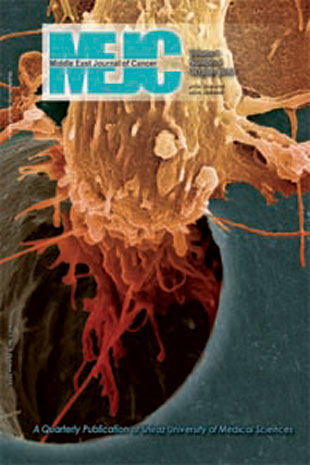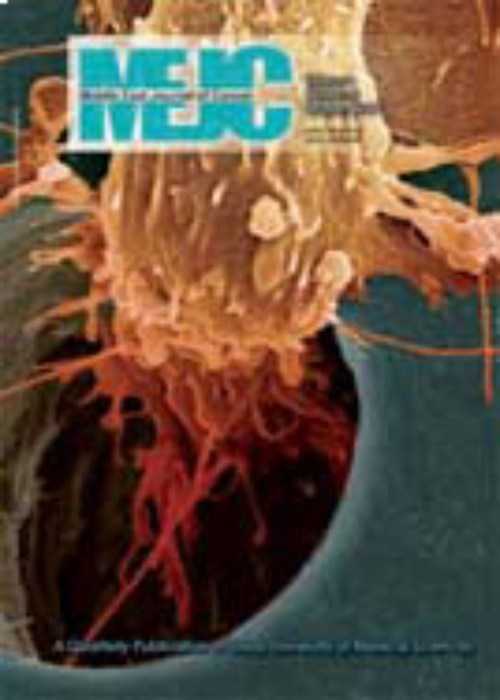فهرست مطالب

Middle East Journal of Cancer
Volume:3 Issue: 1, Jan 2012
- تاریخ انتشار: 1391/06/26
- تعداد عناوین: 5
-
-
Pages 1-8BackgroundBreast carcinoma is the most common malignant tumor and leading cause of cancer deaths in women. While fine needle aspiration cytology is highly accurate in the diagnosis of breast lesions, it possesses certain drawbacks. In those circumstances intraoperative imprint cytology assumes importance, however, imprint cytology is subjected to interpretative errors. Computer image analysis has become an important tool in the pathology laboratory for quantitative morphometric analysis. The purpose of this study was to compare the morphometric values of various breast lesions on intraoperative imprint smears with final histopathological sections.MethodsThe study group comprised 30 cases of, borderline (suspicious), and malignant lesions. Intraoperative imprint smears were stained with hematoxylin and eosin, and toluidine blue. Morphometry was done on these smears and compared with morphometry on the histopathological sections, followed by statistical correlation. We studied the following five parameters: mean nuclear area, mean nuclear diameter, mean nuclear perimeter, feret circle, and nucleo-cytoplasmic ratio.ResultsIn the current work, all of the studied parameters with the exception of feret circle showed significantly lower values in benign ductal epithelial cells compared to malignant lesions and concentrate on the importance of morphometry as a diagnostic tool that could differentiate benign from malignant lesions, especially if it can be employed on imprint smears intraoperatively. Accurate assessment of intraoperative margins by imprint smears using image analysis automation can prevent multiple re- excision procedures in breast conservation surgery.Keywords: Breast carcinoma, Intraoperative cytology, Morphometry
-
Pages 9-13BackgroundChemotherapy is an important treatment for cancer, yet some of its side effects are serious and painful. Many patients with cancer suffer from psychiatric disorders that most likely result from therapeutic drugs or mental strategies to cope with their illness. Progressive muscle relaxation is one of the cost effective, self-help methods that promotes mental health in healthy participants. This study aims to determine the effect of progressive muscle relaxation training on anxiety and depression in cancer patients undergoing chemotherapy.MethodsThis was a randomized, clinical study that enrolled 60 patients who received inpatient chemotherapy in the Tabriz Hematology and Oncology Research Center in 2010. We divided patients into two groups, intervention and control. All participants signed written formal consents and completed the Hospital Anxiety & Depression Scale questionnaires. Intervention group participants were trained in progressive muscle relaxation in groups of 3-6 to enable participants to perform this technique when they were alone in the hospital and after discharge, two to three times each day. After one and three months, questionnaires were completed again by both groups and the results compared. 17th version of SPSS software was used for data analysis.ResultsAfter data analysis, most participants were satisfied with learning and experiencing this technique. There was no significant difference between scales in the case and control groups after one month (P>0.05). However after three months, anxiety and depression considerably improved in patients who underwent progressive muscle relaxation training (P<0.05).ConclusionProgressive muscle relaxation training can improve anxiety and depression in cancer patients.Keywords: Chemotherapy, Quality of life, Cancer, Patients
-
Pages 15-21BackgroundEssential oils are the volatile fraction of aromatic and medicinal plants created after extraction by steam or water distillation. Species of the genus Citrus (Rutaceae) have been widely used in traditional medicine as volatile oils and are currently the subject of numerous research. Citrus essential oil consists of different terpens that have antitumor activities. This study determines the cytotoxic effect of the essential oils of Citrus limon L. peels on a colorectal cancer cell line (LIM1863).MethodsWe harvested four samples from four locations in Syria. Essential oils were prepared by hydrodistillation and analyzed by Gas chromatography-mass spectrometry (GC-MS).Various concentrations ofessential oils (0.5-48 µg/ml) were added to cultured cells and incubated for 72 h. Cell viability was evaluated byMTT-based cytotoxicity assay.ResultsWe noted 18 components that represented 98.81% of the total oil content. The major components were: limonene (61.8%-73.8%), γ-terpinene (9.4%-10.4%), β-pinene (3.7%-6.9%), O-cymene (1%-2.4%),and citral (0.8%-5.4%).The obtained IC50 value range of Citrus limon essential oils was 5.75-7.92 µg/ml against LIM1863.ConclusionThis study revealed that Syrian Citrus limon essential oil has a cytotoxic effect on the human colorectalcarcinoma cell line LIM1863 when studied in vitro.Keywords: Citrus limon, Essential oils, Cytotoxicity, LIM1863
-
Pages 23-25Cutaneous metastases of rectal carcinoma is a rare event. It occurs in fewer than 4% of all patients with rectal cancer. When present, it typically signifies a disseminated disease with a poor prognosis. Early detection and proper diagnosis of metastatic rectal cancer can significantly alter treatment and prognosis. We report a 70-year-old male who underwent rectal resection with permanent colostomy for rectal adenocarcinoma since seven years. The patient recently developed multiple skin nodules, mainly in his face, scalp, and upper trunk, associated with itching. Fine needle aspiration cytology from a face nodule was done which revealed metastatic adenocarcinoma associated with severe inflammation. Cutaneous metastasis of rectal adenocarcinoma is an unusual event that presents mainly in the form of skin nodules and could be the first sign of metastasis. Early diagnosis of cutaneous metastasis in these patients is important because it can alter treatment and prognosis.Keywords: Rectal carcinoma, Adenocarcinoma, Cutaneous, Skin, Metastases
-
Pages 27-30Bladder cancer is one of the most common cancers of men between the ages of 60 to 70 years, but its occurrence in a young pregnant female is unusual. Until now less than 40 cases have been reported. Herein we report our experience in the diagnosis and management of a pregnant female with urothelial neoplasm of low malignant potential who has been treated with transurethral resection during pregnancy. She has had an uneventful pregnancy outcome. The patient also had an episode of recurrence, successfully treated with transurethral resection and intravesicalmitomycin. Keywords:Keywords: Pregnancy, Urothelial neoplasm, Transurethral resection


